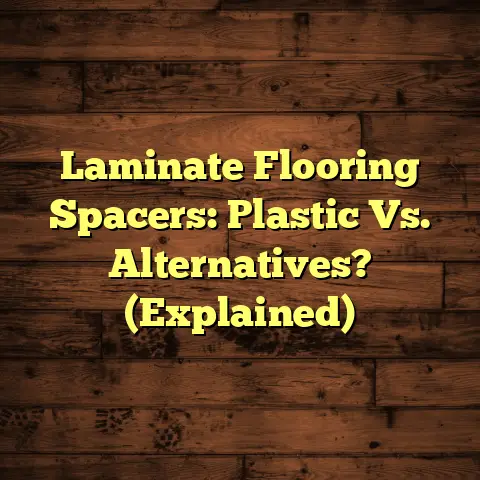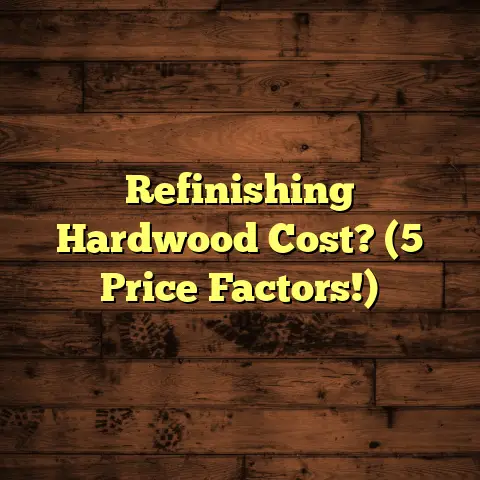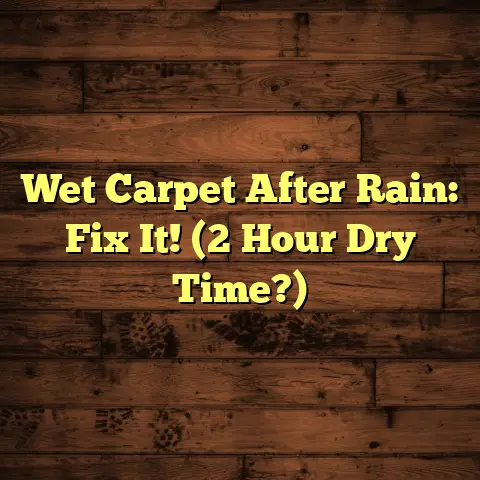How Long Does Garage Paint Last? (8 Year Myth)
We’ve all heard it, right? “Garage paint lasts eight years, easy! Slap it on and forget about it.” Well, I’m here to tell you that’s a myth – a big, fat, potentially expensive myth.
Think of your garage. It’s not just a place to park your car. It’s a workshop, a storage unit, a sometimes-makeshift gym. It takes a beating! So, can a simple coat of paint really hold up for eight years?
In my experience, the answer is usually no.
Why is this important? Because believing this myth can lead to:
- Disappointment: Expecting long-lasting results and getting peeling, cracking paint instead.
- Wasted Money: Re-doing the job sooner than you anticipated.
- Potential Damage: Neglecting your garage floor can lead to concrete damage and bigger problems down the road.
So, let’s dive into the truth about garage paint longevity. I’ll share my insights, based on years of experience, to help you make informed decisions about your garage floor.
Section 1: Understanding Garage Paint
First things first, let’s get clear on what we’re talking about when we say “garage paint.” It’s not just any old paint you’d use on your walls. Garage paint is specifically formulated to withstand the unique challenges of a garage environment.
What is Garage Paint?
Garage paint typically refers to coatings designed for concrete floors. Here’s a breakdown of the common types:
-
Epoxy: This is the heavy-duty champion. Epoxy is a two-part system (resin and hardener) that creates a tough, durable, and chemical-resistant finish. It’s great for high-traffic areas and garages where you work with chemicals or oils.
-
Latex Acrylic: More user-friendly and often less expensive than epoxy, latex acrylic paints are water-based and easier to apply. They offer decent protection but aren’t as resistant to chemicals or heavy wear as epoxy.
-
Oil-Based: While less common these days due to environmental concerns and longer drying times, oil-based paints offer good adhesion and durability. However, they’re often more difficult to work with.
-
Concrete Stain: This penetrates the concrete surface, providing color without a thick coating. It’s a good option for a more natural look, but it doesn’t offer the same level of protection as paint.
The Harsh Garage Environment
Garages aren’t exactly known for being gentle. They face a barrage of challenges that can wreak havoc on paint:
-
Temperature Fluctuations: Extreme hot and cold temperatures can cause the paint to expand and contract, leading to cracking and peeling.
-
Moisture: Water from melting snow, rain tracked in by your car, or even humidity can seep into the concrete and undermine the paint’s adhesion.
-
Chemical Spills: Oil, gasoline, antifreeze, and other chemicals can stain or even dissolve some types of paint.
-
Abrasion: Car tires, dropped tools, and foot traffic all contribute to wear and tear on the paint surface.
The Importance of Primer and Paint Quality
Think of primer as the foundation for your paint job. It helps the paint adhere properly to the concrete, seals the surface, and can even prevent stains from bleeding through.
Using a high-quality primer designed for concrete is crucial for the longevity of your garage floor paint.
And don’t skimp on the paint itself! Cheaper paints often have less pigment and binders, making them less durable and more prone to fading, chipping, and peeling.
Section 2: The Myth of 8-Year Longevity
So, where did this 8-year myth come from? Honestly, it’s hard to pinpoint the exact origin. It’s likely a combination of marketing hype, wishful thinking, and perhaps a few isolated cases where paint actually did last that long under ideal conditions.
Marketing Influences and Consumer Perceptions
Paint manufacturers often tout the longevity of their products, using terms like “durable,” “long-lasting,” and “guaranteed.” While these claims may be technically true under specific circumstances, they often don’t reflect the reality of a typical garage environment.
Consumers, eager to save time and money, often latch onto these claims, hoping for a low-maintenance solution.
Real-World Experiences and Expert Opinions
In my experience, eight years is a very optimistic estimate for the lifespan of garage paint. I’ve seen plenty of garage floors where the paint started failing after just a year or two.
I once worked on a garage where the homeowner had used a standard latex paint, thinking it would be sufficient. Within six months, the paint was peeling and cracking due to hot tire pickup (the tires literally pull the paint off the floor).
Other contractors I’ve spoken with echo this sentiment. They emphasize that proper preparation, high-quality materials, and regular maintenance are essential for extending the life of garage paint.
Factors Contributing to Premature Paint Failure
Here are some of the most common reasons why garage paint fails prematurely:
-
Inadequate Surface Preparation: This is the biggest culprit. If the concrete isn’t properly cleaned, etched, and primed, the paint won’t adhere properly.
-
Improper Application: Applying the paint too thinly, using the wrong type of roller, or painting in extreme temperatures can all lead to problems.
-
Poor Maintenance: Neglecting to clean up spills, allowing water to pool on the floor, or using harsh cleaning chemicals can damage the paint.
Section 3: Factors Influencing Garage Paint Longevity
Okay, so we’ve debunked the 8-year myth. Now, let’s talk about what actually influences how long your garage paint will last.
Surface Preparation: The Foundation for Success
I cannot stress this enough: proper surface preparation is absolutely critical. Here’s what it involves:
-
Cleaning: Remove all dirt, grease, oil, and debris from the concrete surface. You can use a pressure washer or a scrub brush and a degreasing cleaner.
-
Etching: This opens up the pores of the concrete, allowing the primer to penetrate and bond properly. You can use an acid etching solution or a mechanical grinder.
-
Repairing Cracks: Fill any cracks or holes in the concrete with a concrete patching compound.
-
Rinsing: Thoroughly rinse the concrete to remove any residue from the etching solution or patching compound.
-
Drying: Allow the concrete to dry completely before applying primer.
Environmental Conditions: The Unseen Enemy
As we discussed earlier, garages are subject to a wide range of environmental conditions that can impact paint longevity:
- Humidity: High humidity can prevent the paint from drying properly and can lead to moisture buildup under the paint film.
- Temperature: Extreme temperatures can cause the paint to expand and contract, leading to cracking and peeling.
- Sunlight Exposure: UV rays can fade the paint and cause it to become brittle.
To mitigate these effects, consider:
- Choosing a paint that is specifically formulated for exterior use if your garage is exposed to direct sunlight.
- Ensuring proper ventilation in your garage to reduce humidity.
- Applying the paint during moderate temperatures (ideally between 60°F and 80°F).
Type of Paint: Choosing the Right Weapon
As I mentioned earlier, different types of garage paint offer varying levels of durability and resistance.
Epoxy is generally considered the most durable option, offering excellent resistance to chemicals, abrasion, and hot tire pickup. However, it’s also more expensive and requires more careful application.
Latex acrylic paints are a more affordable and user-friendly option, but they’re not as durable as epoxy. They’re best suited for garages with light traffic and minimal exposure to chemicals.
Here’s a quick comparison table:
| Feature | Epoxy | Latex Acrylic |
|---|---|---|
| Durability | Excellent | Good |
| Chemical Resistance | Excellent | Fair |
| Abrasion Resistance | Excellent | Good |
| Cost | Higher | Lower |
| Ease of Application | More challenging | Easier |
Usage Patterns: How You Use Your Garage Matters
The way you use your garage will also affect the lifespan of your paint.
- Heavy Traffic: If you frequently drive in and out of your garage, the paint will wear down more quickly.
- Chemical Spills: Regularly spilling oil, gasoline, or other chemicals on the floor can damage the paint.
- Storage Habits: Storing heavy items directly on the painted surface can cause scratches and abrasions.
To minimize wear and tear, consider:
- Using floor mats in high-traffic areas.
- Cleaning up spills immediately to prevent staining and damage.
- Protecting the floor with a sealant to improve its resistance to chemicals and abrasion.
Expert Insights: Best Practices for Maximizing Durability
I’ve learned a few tricks of the trade over the years. Here are some of my top tips for maximizing the lifespan of your garage paint:
- Always follow the manufacturer’s instructions for surface preparation and application.
- Apply multiple thin coats rather than one thick coat.
- Use a high-quality roller designed for epoxy or concrete paint.
- Allow the paint to cure completely before parking your car or placing heavy items on the floor.
- Reapply a clear coat sealant every few years to protect the paint from wear and tear.
Section 4: Maintenance and Care
Even with the best preparation and materials, your garage paint will eventually require some maintenance. Regular cleaning and care can significantly extend its lifespan.
Cleaning Painted Garage Floors: A Step-by-Step Guide
Here’s my recommended cleaning routine:
- Sweep or vacuum the floor to remove loose dirt and debris.
- Mix a mild detergent (like dish soap) with warm water.
- Scrub the floor with a soft-bristled brush or mop.
- Rinse thoroughly with clean water.
- Allow the floor to dry completely.
Avoid using harsh chemicals like bleach or ammonia, as these can damage the paint.
Warning Signs of Paint Deterioration: When to Reapply
Keep an eye out for these warning signs:
- Peeling or cracking paint.
- Fading or discoloration.
- Stains that won’t come clean.
- Loss of adhesion (the paint feels loose or brittle).
If you notice any of these issues, it’s time to consider reapplying the paint.
Section 5: Alternatives to Traditional Garage Paint
While garage paint is a popular choice, it’s not the only option for protecting and beautifying your garage floor. Here are some alternatives:
-
Epoxy Coatings (Professional Grade): While I mentioned epoxy paint earlier, professional-grade epoxy coatings are a different beast. They are thicker, more durable, and often come with decorative flakes or metallic pigments. They are significantly more expensive but offer a much longer lifespan.
-
Garage Floor Tiles: These interlocking tiles are made of durable plastic or rubber and provide a comfortable, slip-resistant surface. They’re easy to install and maintain.
-
Vinyl Flooring: Vinyl flooring is another durable and easy-to-clean option. It comes in a variety of colors and patterns.
-
Concrete Staining: As mentioned earlier, concrete staining penetrates the concrete surface, providing color without a thick coating. It’s a good option for a more natural look, but it doesn’t offer the same level of protection as paint.
Here’s a comparison of these alternatives:
| Feature | Epoxy Coating (Pro) | Garage Floor Tiles | Vinyl Flooring | Concrete Staining |
|---|---|---|---|---|
| Durability | Excellent | Excellent | Good | Fair |
| Chemical Resistance | Excellent | Good | Good | Fair |
| Cost | High | Moderate | Moderate | Low |
| Ease of Installation | Challenging | Easy | Moderate | Moderate |
Section 6: Conclusion
So, there you have it! The 8-year myth debunked. Garage paint can be a great way to improve the look and functionality of your garage, but it’s important to have realistic expectations.
By understanding the factors that influence paint longevity, choosing the right materials, and following proper maintenance procedures, you can significantly extend the life of your garage floor paint.
Remember, investing in your garage is an investment in your property. Take the time to do it right, and you’ll enjoy a beautiful and functional garage for years to come.
References and Further Reading
- The Family Handyman: https://www.familyhandyman.com/
- This Old House: https://www.thisoldhouse.com/
- Concrete Decor Magazine: https://www.concretedecor.net/
- Manufacturer websites (e.g., Rust-Oleum, Sherwin-Williams) for product-specific information and technical data sheets.
I hope this article has been helpful. Happy painting!





